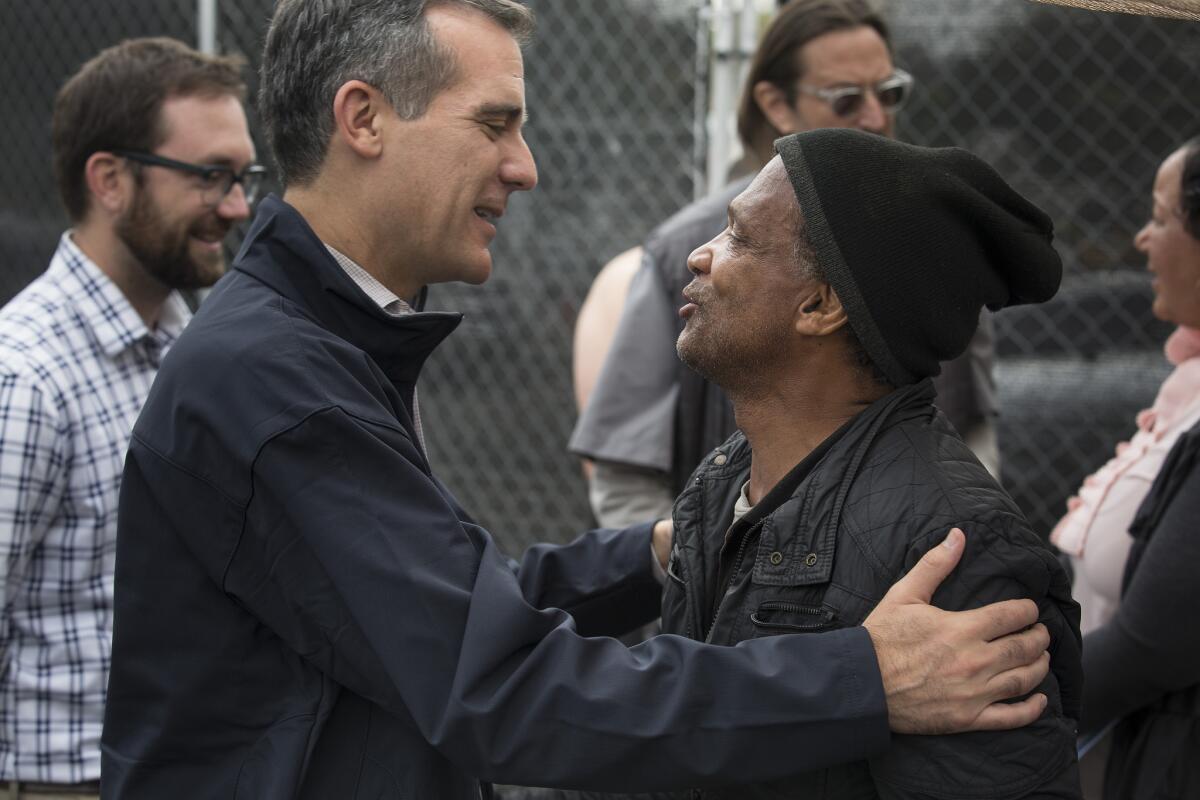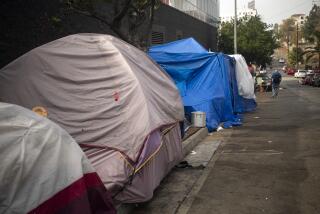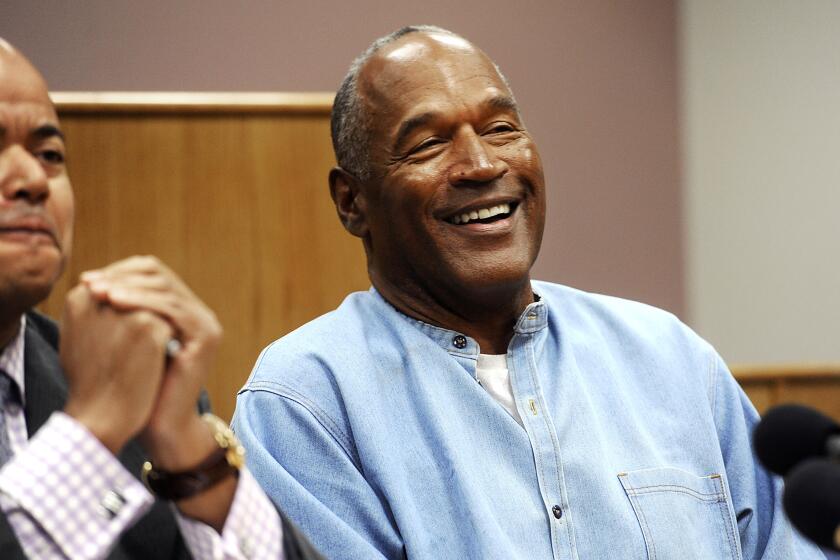L.A.’s homelessness math is a bit off — totals are the same but increases are smaller

When the Los Angeles Homeless Services Authority released the 2016 homeless count earlier this month, the takeaway was grim.
Homelessness was up 5.7% across the county. In the city of Los Angeles the change was even greater: a year-over-year increase of 11%
The numbers suggested that the homeless population was still growing, even after a year of increasingly intense measures to reduce it, and that the city experienced an increase last year almost as great as in the previous two years.
But neither of the numbers was correct.
The actual growth in homelessness in the city and the county is much less than indicated in the report, based on a Times analysis and corrected figures provided by the homelessness agency. Agency officials concurred that homelessness grew about 5% in the city and less than half a percent across the county.
The figures are considered estimates because they are based on a street count supplemented with statistical extrapolations.
The 5.7% and 11% increases released by the agency during a May 3 news conference — and reported by The Times and several other news outlets — reflected a change in methodology that included a special count of homeless people under 25 in hard-to-find places.
Because a separate youth count was not included in 2015, it should have been subtracted from the 2016 count to make a valid comparison of the two years.
The revised year-over-year comparison doesn’t change the authority’s estimate for the total number of homeless people in 2016: 28,464 in the city and 46,874 countywide.
It is my expectation that all departments will be thorough in collecting and cleaning any data before it is presented to the public.
— Mayor Eric Garcetti, in a statement, after certain numbers were revised by the L.A. Homeless Services Authority after the agency released results of this year’s homeless count
Peter Lynn, the government agency’s executive director, said the youth count makes the 2016 tally the most accurate estimate of total homelessness yet, providing a good baseline for future years. But he acknowledged that comparing the two years without removing the youth counts would yield an exaggerated increase.
In essence, the 2,388 youths added to the countywide total represented a measurement adjustment, not a real increase.
During the news conference, Lynn noted that the new youth count made up a large portion of the increase in the city, and one chart in the visual presentation showed an increase of only 2.7% if the youth count was excluded.
But the chart headline stated boldly, “City of Los Angeles saw an 11% increase in total homelessness,” without a clear disclaimer that it was not an apples-to-apples change.
No similar apples-to-apples calculation was included at all in the chart showing a 5.7% increase for the entire county.
Lynn focused his comments on the brighter portions of the count — decreases of homeless veterans and families that he attributed to intensive efforts by the city and county.
For Los Angeles Mayor Eric Garcetti, Lynn’s acknowledgement of the lower number for the city represents a validation, if only a partial one.
On the day of the presentation, Garcetti’s staff released an analysis suggesting that, after adjusting for the youth count, the most reasonable year-over-year gain was about 3%.
Though the logic behind that figure was right, the number itself turned out to be wrong.
After discovering a math error, the homeless authority has since nearly doubled the apples-to-apples change for the city from 2.7% to 5.2%.
Garcetti took the change in stride.
“Solving our homelessness crisis is a top priority for me, and having accurate data is fundamental to helping us better understand the scale of the problem and finding smarter, more efficient ways to get unsheltered Angelenos off the street and into homes,” the mayor said in a statement after learning that LAHSA had changed the number. “It is my expectation that all departments will be thorough in collecting and cleaning any data before it is presented to the public.”
The conflicting interpretations of the count highlight some of the foibles inherent in tracking homelessness from year to year. Though the authority reports the homeless numbers down to the individual person, they are, in fact, only estimates.
The methodology has been evolving since the first count in 2005, and every change adds to the potential error in year-over-year comparisons. One of the biggest changes has been the homeless agency’s expanding volunteer base, allowing counters to cover more streets for each January survey.
The 2015 count reached nearly 90% of the census tracts in the county minus Glendale, Long Beach and Pasadena, which conduct separate counts. That was up from barely a quarter of tracts in 2005. The agency’s statistical consultant at the University of North Carolina uses mathematical models to extrapolate numbers in the tracts that were not counted.
This year, volunteers made counts in 100% of the tracts — a change that could have raised or lowered the homeless tally in tracts where statistical modeling was used the year before.
Another element of uncertainty comes from the estimates of people living in tents, cars and recreational vehicles. Volunteers are instructed not to look inside. The statistician uses a separate homeless survey to create a multiplier for each type of habitation. In 2015, each car was multiplied to 1.17 people, for example, and each tent to 1.55 people. In 2016, the factors changed to 1.48 people per car and 1.56 per tent.
The youth count was added this year to address a long-known problem with counting the homeless — that minors on the street are harder for volunteers to find because they tend to shun adults, taking refuge in more secure places such as rooftops.
Volunteers trained in identifying youth canvassed only about one-sixth of the census tracts. Their tallies were employed in statistical modeling to come up with numbers for the uncanvassed tracts.
The melding of the two counts raised the problem of duplication. On the big count, volunteers were asked to identify unaccompanied youths and minors in families. Those tallies were then removed from the youth count.
Because the counts are estimates, they come with a margin of error, like a poll. Even an unusually small margin of error could mean that homelessness countywide actually declined slightly in this year’s count. But the agency has not published a precise margin of error.
Times staff writers Gale Holland, Peter Jamison and Jon Schleuss contributed to this report.
Join the conversation on Facebook >>
ALSO
Two L.A. councilmen want you to vote for $1-billion measure to house the homeless
Killings in L.A. are still on the rise, but police chief sees a ‘turn of the tide’
California’s teacher tenure battle is reignited by Vergara appeal and a new bill
More to Read
Start your day right
Sign up for Essential California for news, features and recommendations from the L.A. Times and beyond in your inbox six days a week.
You may occasionally receive promotional content from the Los Angeles Times.







